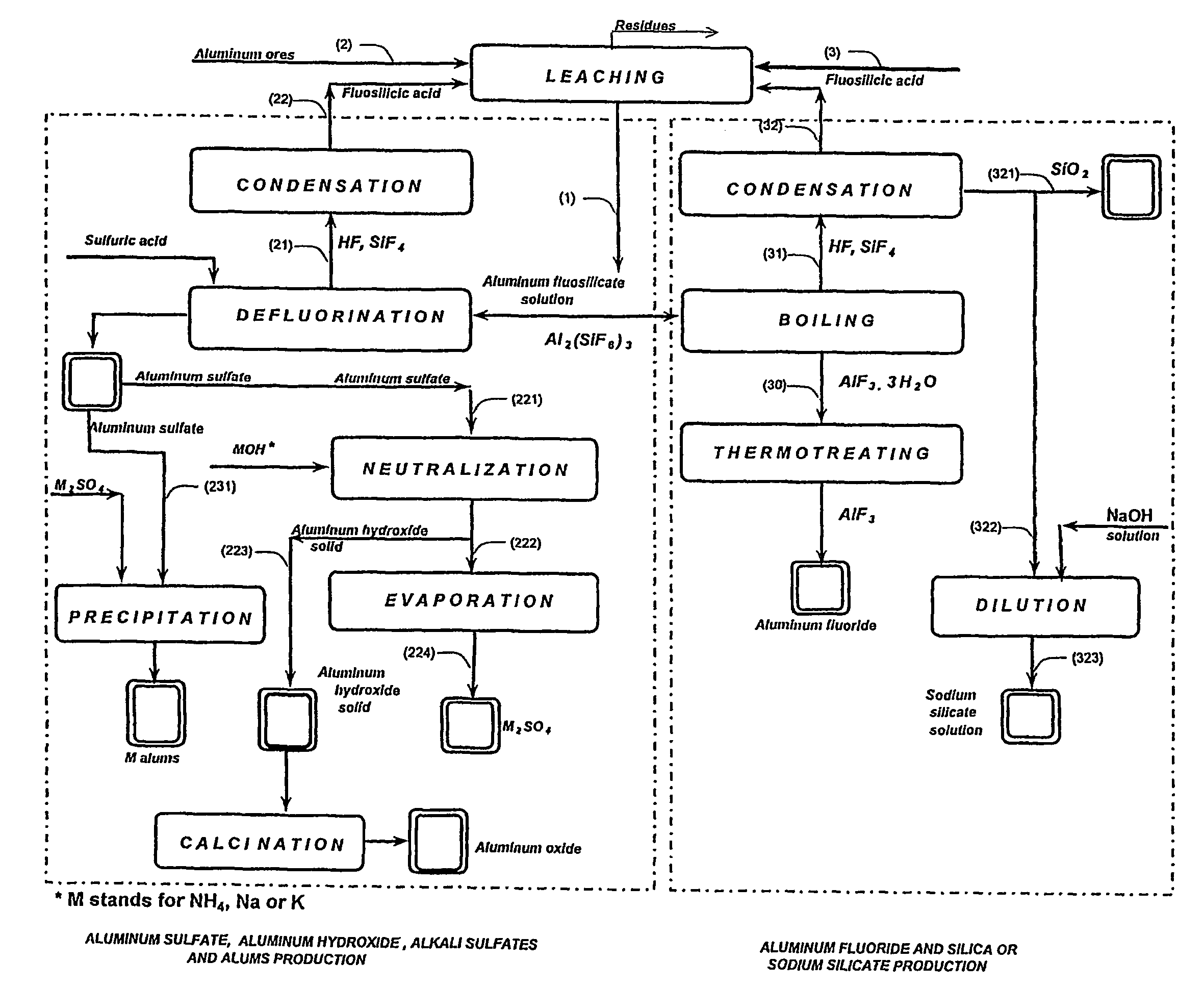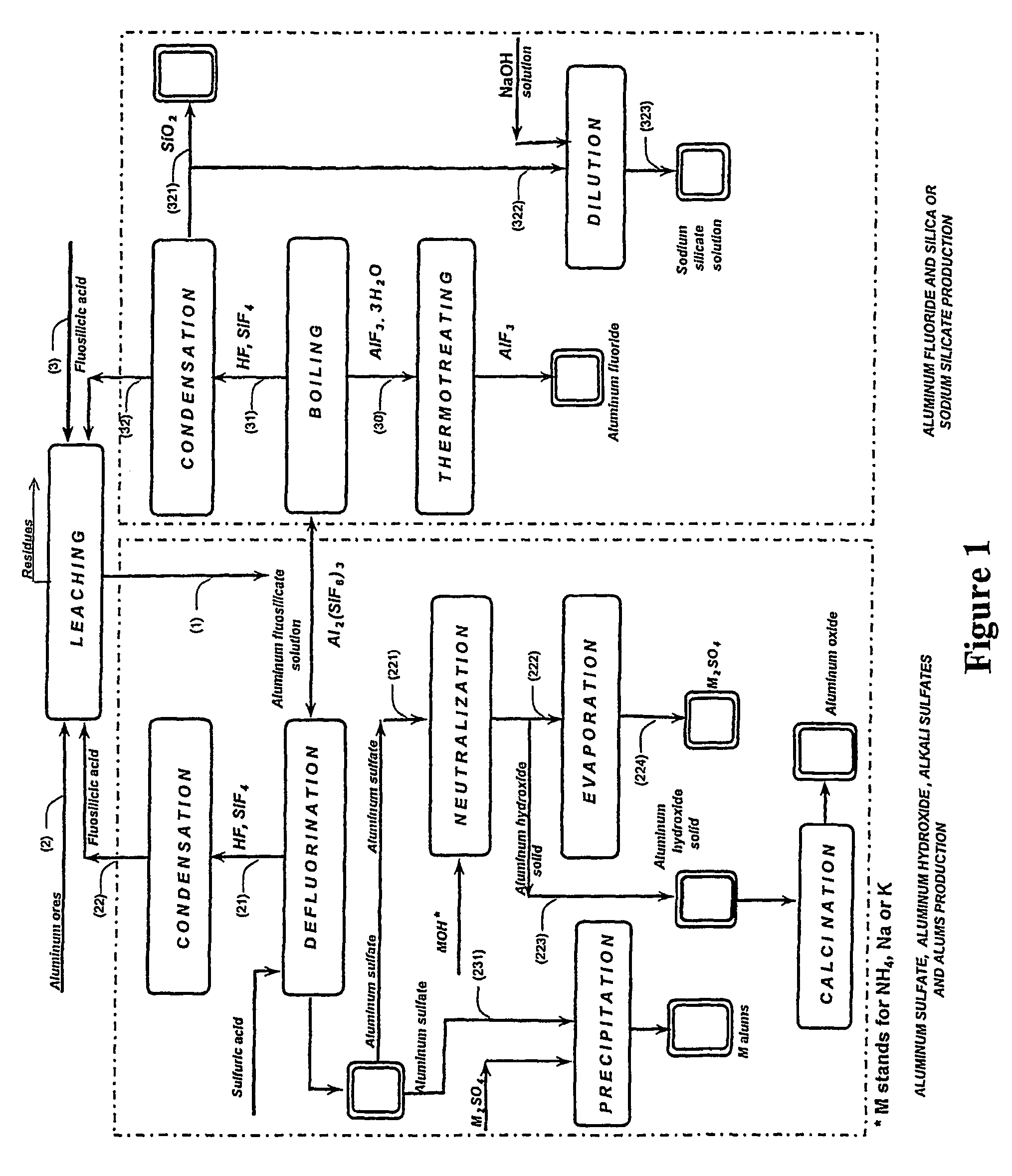Production of aluminum compounds and silica from ores
a technology of inorganic aluminum compounds and silica, which is applied in the direction of silicates, separation processes, dissolving, etc., can solve the problems of complex and costly process, process that is more than 15 stages, and drawback of aforementioned process,
- Summary
- Abstract
- Description
- Claims
- Application Information
AI Technical Summary
Benefits of technology
Problems solved by technology
Method used
Image
Examples
example 1
[0053]A sample of 50.0 g of clay, comprising 35.5% of aluminum oxide, was admixed by means of magnetic stirrer with fluosilicilic acid (27.7%, 322.0 g) for 60 min at about 65° C. The slurry was filtered, and the insoluble substances were washed (54.9 g) and subsequently dried (35.0 g), the dissolution of 83% of aluminum oxide was achieved.
[0054]Filtrate comprising aluminum fluosilicate (446.0 g) was evaporated to 200 g. Obtained precipitate comprising aluminum fluoride tri-hydrate was filtered, washed (34.7 g) and dried at 110÷C to yield 25.1 g product. An amount of 22.6 g of said aluminum fluoride trihydrate product was furtherly heated for six hours at 550÷C to yield pure aluminum fluoride anhydrous (13.3 g), as was analyzed by means of X-ray diffraction analysis. This final product contained 0.1% of ferric oxide and less than 0.1% of calcium oxide, and traces of silica. 83% of the aluminum oxide from the clay was dissolved in this process, wherein the overall transfer yield of al...
example 2
[0055]A sample of 50.0 g of clay, comprising 35.5% of aluminum oxide was admixed by means of magnetic stirrer with fluosilicilic acid (27.7%, 330.0 g) for 60 min at about 65÷C. The slurry was filtered, and the insoluble substances were washed (55.0 g) and subsequently dried (35.2 g). Dissolution of 80.9% aluminum oxide was achieved. Aluminum fluosilicate containing filtrate (380.0 g) was evaporated to 200 g. Obtained precipitate was filtered, washed (33.8 g) and dried at 110÷ to 24.5 g product, comprising aluminum fluoride trihydrate. Said aluminum fluoride trihydrate product was first heated to 250÷C and than two hours at 550÷C to yield pure aluminum fluoride anhydrous (15.0 g) was found, as was defined by means of X-ray diffraction analysis. This product contained 0.1% of ferric oxide, less than 0.1% of calcium oxide containing residuals and traces of silica. 0.3% of the aluminum oxide present in the clay was dissolved in this process, wherein the overall transfer yield of aluminu...
example 3
[0059]Experiment as described above, wherein the evaporation of aluminum fluosilicate was performed to a smaller volume of 75 ml. The aluminum oxide from the clay was dissolved to 84.3% and by evaporation to a smaller volume the overall yield of the aluminum fluoride increased to 89.9%.
[0060]The analysis of the sample 3 was 33.0% Altotal, 63.7% F, 0.10% Fe2O3, 0.08% SiO2, 0.1% CaO, corresponding to 93.9% AlF3 and 5.4% Al2O3.
PUM
| Property | Measurement | Unit |
|---|---|---|
| Temperature | aaaaa | aaaaa |
| Temperature | aaaaa | aaaaa |
| Temperature | aaaaa | aaaaa |
Abstract
Description
Claims
Application Information
 Login to View More
Login to View More - R&D
- Intellectual Property
- Life Sciences
- Materials
- Tech Scout
- Unparalleled Data Quality
- Higher Quality Content
- 60% Fewer Hallucinations
Browse by: Latest US Patents, China's latest patents, Technical Efficacy Thesaurus, Application Domain, Technology Topic, Popular Technical Reports.
© 2025 PatSnap. All rights reserved.Legal|Privacy policy|Modern Slavery Act Transparency Statement|Sitemap|About US| Contact US: help@patsnap.com


